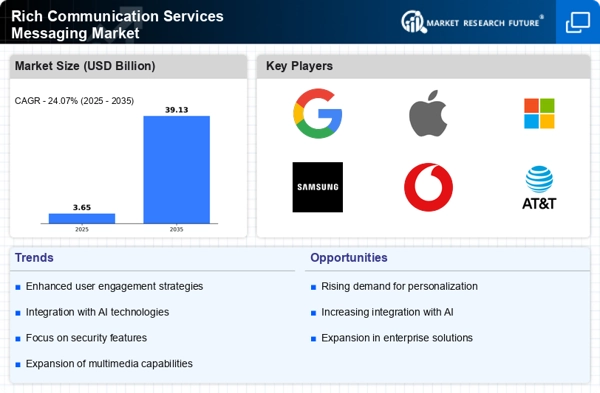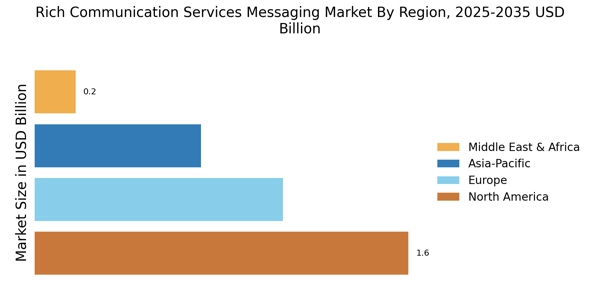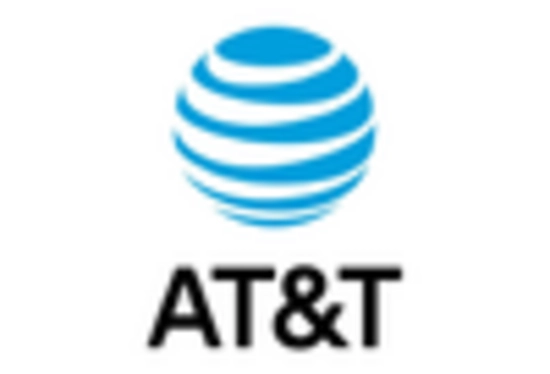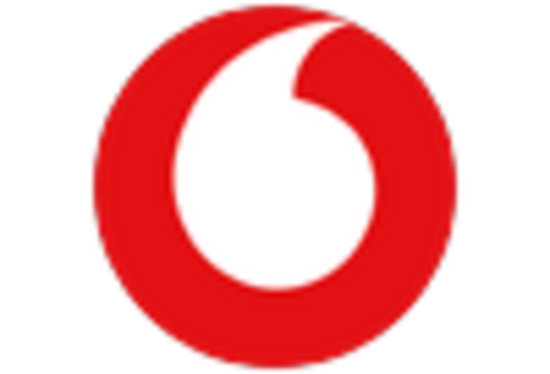Increased Adoption of Mobile Devices
The proliferation of mobile devices has been a driving force in the Rich Communication Services Messaging Market. As smartphone penetration continues to rise, users increasingly seek advanced messaging capabilities that go beyond traditional SMS. This trend is evidenced by the fact that, as of 2025, over 80% of mobile users are expected to utilize smartphones, creating a substantial demand for rich communication services. Enhanced features such as multimedia sharing, group chats, and interactive elements are becoming essential for user engagement. Consequently, businesses are compelled to adopt RCS messaging to meet consumer expectations and remain competitive. This shift not only enhances user experience but also opens new avenues for marketing and customer interaction, thereby propelling the growth of the Rich Communication Services Messaging Market.
Regulatory Support and Standardization
Regulatory support and standardization are emerging as critical factors influencing the Rich Communication Services Messaging Market. Governments and regulatory bodies are increasingly recognizing the need for standardized messaging protocols to ensure interoperability and security. This is particularly relevant as businesses seek to implement RCS messaging solutions that comply with local regulations while providing a seamless user experience. The establishment of guidelines and frameworks for RCS adoption is expected to foster trust among consumers and businesses alike. Moreover, as more countries implement regulations that promote digital communication, the adoption of RCS messaging is likely to accelerate. This regulatory environment not only encourages innovation but also enhances the overall credibility of the Rich Communication Services Messaging Market, making it a more attractive option for businesses looking to enhance their communication strategies.
Advancements in Technology and Infrastructure
Technological advancements play a pivotal role in shaping the Rich Communication Services Messaging Market. The ongoing development of 5G networks is particularly noteworthy, as it facilitates faster data transmission and improved connectivity. This enhancement allows RCS messaging to deliver richer content, such as high-resolution images and videos, without compromising speed or quality. Furthermore, the integration of artificial intelligence and machine learning into messaging platforms is enabling businesses to automate responses and personalize interactions. As these technologies continue to evolve, they are expected to enhance the functionality and appeal of RCS messaging. The anticipated growth in 5G adoption, projected to reach over 1 billion connections by 2026, underscores the potential for RCS to transform communication experiences. Thus, advancements in technology and infrastructure are likely to be a significant driver in the Rich Communication Services Messaging Market.
Growing Demand for Enhanced Customer Engagement
In the current landscape, businesses are increasingly recognizing the importance of customer engagement, which significantly influences the Rich Communication Services Messaging Market. Companies are leveraging RCS messaging to create personalized and interactive communication channels with their customers. This approach is particularly effective in sectors such as retail and hospitality, where timely and relevant messaging can enhance customer satisfaction and loyalty. According to recent data, businesses utilizing RCS have reported up to a 30% increase in customer engagement rates compared to traditional SMS. This trend indicates a shift towards more dynamic and engaging communication strategies, which are essential for maintaining competitive advantage in the market. As organizations continue to prioritize customer experience, the demand for RCS messaging solutions is likely to escalate, further driving the growth of the Rich Communication Services Messaging Market.
Shift Towards Omnichannel Communication Strategies
The shift towards omnichannel communication strategies is significantly impacting the Rich Communication Services Messaging Market. Businesses are increasingly adopting integrated communication approaches that encompass various channels, including social media, email, and messaging apps. RCS messaging is positioned as a vital component of these strategies, offering a cohesive and interactive platform for customer interactions. This trend is driven by the need for businesses to provide a seamless experience across all touchpoints, which is essential for customer retention and satisfaction. Data suggests that companies employing omnichannel strategies can achieve a 10% increase in customer retention rates. As organizations recognize the value of cohesive communication, the demand for RCS messaging solutions is expected to rise, further propelling the growth of the Rich Communication Services Messaging Market.


















Leave a Comment